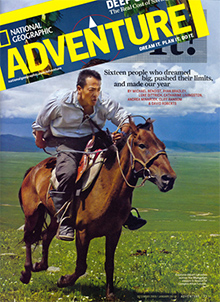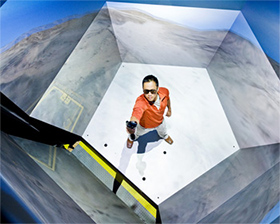National Geographic Adventure Magazine Labels
Calit2 Researcher Among Top 10 Adventurers of the Year
Doug Ramsey | December 14, 2009

In this page from National Geographic Adventure's December-January issue, Calit2 Research Scholar Albert Lin rides the steppe during last summer's expedition to Mongolia in search of Genghis Khan's burial site.
It’s not often that a materials scientist by training gets to be labeled one of the world’s top adventurers. But that’s the honor bestowed on Calit2 research scholar Albert Yu-Min Lin, 28, in the December 2009-January 2010 issue of National Geographic Adventure magazine. Lin is affiliated with Calit2’s Center of Interdisciplinary Science for Art, Architecture and Archaeology (CISA3).
Separately, the magazine’s online edition (see link below) decided to ask readers to rank Lin and his fellow honorees to determine the Readers’ Choice for top adventurer of the year from among “the outstanding individuals who made our year in exploration, conservation, action sports and humanitarian work.” As of December 7, Lin was leading in the survey, in part in recognition of the audacity of his adventure – to solve a nearly 800-year-old mystery by pinpointing the lost burial site of Genghis Khan.
Lin earned his Ph.D. in materials science and engineering from UC San Diego’s Jacobs School of Engineering in 2008. After graduation, “his mother, a former Hong Kong movie star, and his father, an astrophysicist, both urged him to get on with things as soon as possible, to find a job that would allow him to eat more steak, less ramen,” writes Luke Dittrich in the feature article, “Conjuring the Great Khan”, that is part of NG Adventure’s cover story. “Instead, Lin decided to begin his post-[doctoral] graduate career by organizing a high-risk, high-stakes project, one that offered little stability and even less promise of success.”
Instead, Lin launched the “Valley of the Khans” project, initially using satellite maps supplied by the GeoEye Foundation to search for tell-tale signs of Genghis Khan’s resting place. Then, with a grant from the National Geographic/Waitt Family Foundation program, Lin undertook an expedition in summer 2009 to Mongolia to deploy an unmanned aerial vehicle (UAV) to help identify any man-made anomalies. Along with National Geographic Resident Archaeologist, Fredrick Hiebert, Lin and his team of engineers, geologists, historians and archaeologists, set out to assist Mongolia's top scholars from the Mongolian Academy of Science with technologies that might enable them to steward the protection of the collective cultural heritage. "Every moment was an adventure," recalls Expedition Field Systems Engineer Nathan Ricklin. "We never knew what we would find next."

Returning from the expedition to Mongolia, Albert Lin navigates a 3D computer model of the terrain in Calit2's StarCAVE virtual-reality environment.
The National Geographic Adventure article notes that, “since his return to the States, [Lin] has continued his discoveries, transforming real-world data into the virtual world of the StarCAVE and canvassing terrain he couldn’t reach in the field… adding one more major site of interest to his list.” The magazine was referring to Calit2’s StarCAVE virtual-reality environment, one of several visualization systems Lin is using to scrutinize satellite images as well as photos and videos captured during the 3-week expedition in Mongolia.
The study will continue until next summer, when Lin will lead a second expedition to study the most promising sites – using non-invasive imaging to look beneath the ground’s surface for clues to the location of Genghis Khan’s tomb, to observe longtime restrictions on traditional archaeological tools that might damage the sites or disrespect the iconic leader’s memory in a country where Genghis Khan is considered by many as the most powerful shaman to have ever lived.
Albert Lin is pleased to see his project winning praise – and funding – from National Geographic, especially because he’s trying to rewrite the rules of archaeological expeditions and discovery. “Archaeology has always depended on digging in the dirt to confirm a discovery and to retrieve remnants of our past,” says Lin. “CISA3 and the Valley of the Khans project see an alternative, because multispectral scanning, ground-penetrating radar, satellite and other noninvasive imaging tools have become so portable and powerful that we should be able to pinpoint underground structures and even bones and other relics. We don’t need a shovel to identify a burial site, especially one the size of what we believe would have surrounded Genghis Khan’s grave. This is new technology that will allow us to preserve the past while also giving the world images that eliminate the need to dig up ruins to preserve cultural heritage.”
Voting for National Geographic Adventure’s first-ever Readers’ Choice Adventurer of the Year will continue through mid-January, with the winner to be announced January 19. Readers are invited to click through in-depth profiles, videos and photo galleries, and then rate Lin and his fellow honorees on a scale of one to ten. They range from an astronaut, wounded soldier-mountaineer and ‘sky flier’ to a biogeochemist, ‘ultra runner’ and educator in Afghanistan who runs an army of teachers who reach more than 10,000 students every year. To cast your ballot for the Adventurer of the Year, go here.
Related Links
National Geographic Adventure
National Geographic/Waitt Family Foundation Grants
Valley of the Khans Project
CISA3
GeoEye Foundation

|